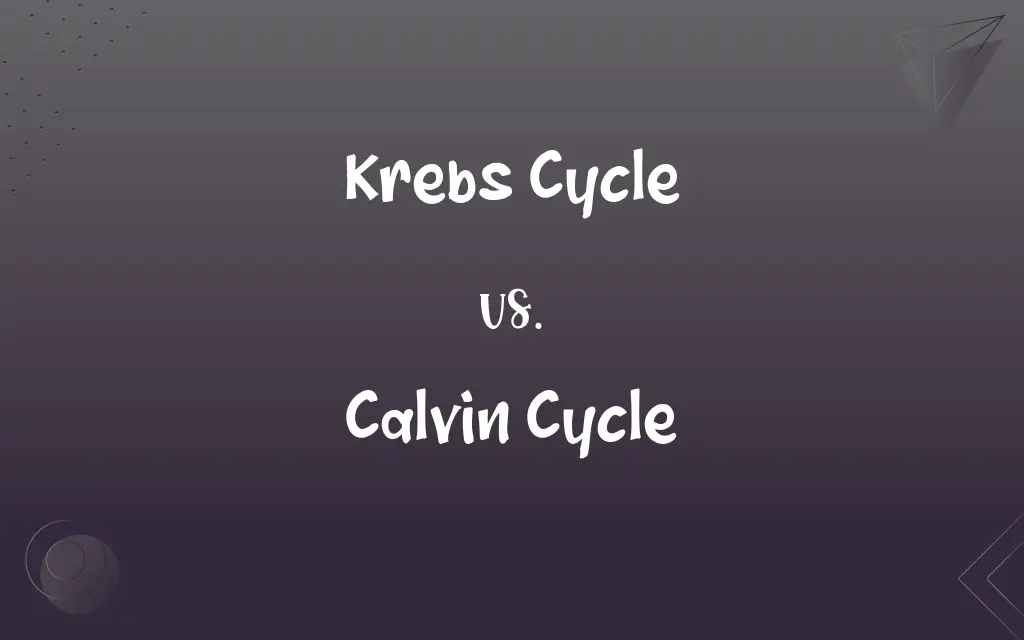Krebs Cycle vs. Calvin Cycle: What's the Difference?
Edited by Aimie Carlson || By Janet White || Published on January 23, 2024
The Krebs Cycle is a series of chemical reactions in cellular respiration that generate energy in the mitochondria of cells, whereas the Calvin Cycle is a process of photosynthesis occurring in the chloroplasts of plants, producing glucose.

Key Differences
The Krebs Cycle occurs in the mitochondria of cells and is integral to cellular respiration, breaking down organic molecules to produce ATP, the energy currency of the cell. In contrast, the Calvin Cycle takes place in the chloroplasts of plant cells, playing a crucial role in photosynthesis by converting carbon dioxide and other compounds into glucose.
In the Krebs Cycle, energy is released from organic compounds, primarily in the form of ATP, NADH, and FADH2. The Calvin Cycle, however, utilizes energy (ATP and NADPH) produced by the light-dependent reactions of photosynthesis to fix atmospheric carbon dioxide into organic sugars.
The Krebs Cycle is a true cycle where the end product, oxaloacetate, is also a reactant, making it a closed loop. The Calvin Cycle, while often referred to as a cycle, is part of a larger linear process of photosynthesis, where the end products are carbohydrates that are not immediate reactants in the cycle.
The Krebs Cycle is a central part of aerobic respiration, linked to other processes like glycolysis and the electron transport chain. The Calvin Cycle is one phase of photosynthesis, interconnected with the light-dependent reactions.
The Krebs Cycle is found in almost all aerobic organisms, including animals, plants, and many microorganisms, reflecting its fundamental role in energy production. The Calvin Cycle, however, is specific to plants, algae, and certain bacteria that perform photosynthesis.
ADVERTISEMENT
Comparison Chart
Location
Mitochondria of cells
Chloroplasts of plant cells
Primary Function
Produces energy (ATP) through the breakdown of molecules
Converts CO2 into glucose during photosynthesis
Energy Utilization
Generates ATP, NADH, FADH2
Uses ATP and NADPH
Process Type
Part of cellular respiration
Phase of photosynthesis
Occurrence in Organisms
Found in most aerobic organisms
Specific to plants and some bacteria
ADVERTISEMENT
Krebs Cycle and Calvin Cycle Definitions
Krebs Cycle
A sequence of enzymatic reactions in cellular respiration.
The Krebs Cycle is crucial for energy production in aerobic organisms.
Calvin Cycle
A mechanism for carbon fixation in plants and certain algae.
The Calvin Cycle contributes to the global carbon cycle.
Krebs Cycle
A series of chemical reactions in the mitochondria.
The Krebs Cycle is often studied in biochemistry for its role in energy metabolism.
Calvin Cycle
A sequence of reactions converting inorganic to organic material.
Without the Calvin Cycle, plants couldn't produce oxygen and glucose.
Krebs Cycle
An essential pathway in aerobic respiration.
Inhibiting the Krebs Cycle can lead to decreased energy production in cells.
Calvin Cycle
Part of the light-independent reactions in photosynthesis.
The Calvin Cycle operates in the chloroplasts of green plants.
Krebs Cycle
A cyclic process producing ATP, NADH, and FADH2.
During intense exercise, the Krebs Cycle accelerates to meet increased energy demands.
Calvin Cycle
A process utilizing ATP and NADPH to synthesize organic compounds.
In the Calvin Cycle, energy from sunlight is stored in sugar molecules.
Krebs Cycle
Part of the metabolic process converting carbohydrates, fats, and proteins into carbon dioxide and water.
The Krebs Cycle plays a key role in metabolizing dietary nutrients.
Calvin Cycle
A biochemical pathway in photosynthesis forming glucose from CO2.
The Calvin Cycle is vital for plant growth and development.
FAQs
Where does the Krebs Cycle occur?
It occurs in the mitochondria of aerobic organisms.
What is the Krebs Cycle?
It's a series of reactions in cellular respiration producing energy in mitochondria.
What is the Calvin Cycle?
It's part of photosynthesis in plants, converting CO2 to glucose in chloroplasts.
Is the Calvin Cycle dependent on light?
It's a light-independent process but relies on products from light-dependent reactions.
Where does the Calvin Cycle take place?
It takes place in the chloroplasts of plants and some bacteria.
What does the Krebs Cycle produce?
It produces ATP, NADH, and FADH2 for energy.
How does the Krebs Cycle affect energy levels in a cell?
It increases energy levels by producing ATP.
Do animals have a Calvin Cycle?
No, it's exclusive to photosynthetic organisms like plants.
Can the Krebs Cycle function without oxygen?
No, it requires oxygen to operate.
What is the main function of the Calvin Cycle?
Its main function is to fix atmospheric CO2 into sugars.
What are the end products of the Krebs Cycle?
Carbon dioxide, ATP, NADH, and FADH2.
Is the Krebs Cycle aerobic or anaerobic?
It is an aerobic process requiring oxygen.
How is the Calvin Cycle related to photosynthesis?
It's a phase of photosynthesis, specifically the light-independent reactions.
How does the Calvin Cycle contribute to plant growth?
It synthesizes sugars that are essential for plant growth.
What would happen if the Krebs Cycle was disrupted?
Disruption can lead to reduced energy production and metabolic issues.
What role does the Krebs Cycle play in metabolism?
It's crucial for the breakdown and utilization of carbohydrates, fats, and proteins.
Why is the Calvin Cycle important for the environment?
It helps in removing atmospheric CO2, contributing to oxygen production and carbon fixation.
What factors affect the Calvin Cycle?
Factors include light intensity, temperature, and availability of CO2 and water.
What enzymes are involved in the Krebs Cycle?
Key enzymes include citrate synthase and isocitrate dehydrogenase.
What are the inputs for the Calvin Cycle?
Carbon dioxide, ATP, and NADPH.
About Author
Written by
Janet WhiteJanet White has been an esteemed writer and blogger for Difference Wiki. Holding a Master's degree in Science and Medical Journalism from the prestigious Boston University, she has consistently demonstrated her expertise and passion for her field. When she's not immersed in her work, Janet relishes her time exercising, delving into a good book, and cherishing moments with friends and family.
Edited by
Aimie CarlsonAimie Carlson, holding a master's degree in English literature, is a fervent English language enthusiast. She lends her writing talents to Difference Wiki, a prominent website that specializes in comparisons, offering readers insightful analyses that both captivate and inform.







































































